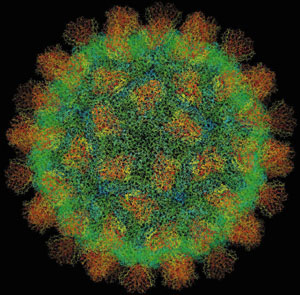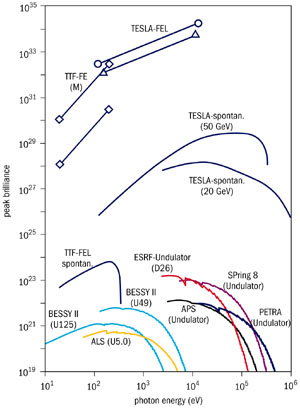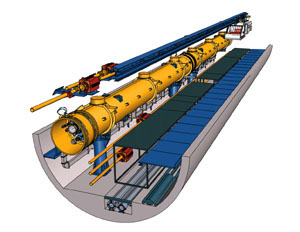The DESY laboratory in Hamburg recently published plans for a superconducting linear electron-positron collider: TESLA. This article amplifies these ambitious plans and outlines the objectives of the project.

At a major event held at the DESY laboratory in March, the international TESLA collaboration, together with the members of various study groups, released the TESLA Technical Design Report. This five-volume opus presented the final facts and figures concerning a grand plan for the future: the “TeV-Energy Superconducting Linear Accelerator”, a 33 km electron-positron linear collider with an integrated X-ray laser laboratory.
To be built near the DESY laboratory in Hamburg, the facility would not only provide particle collision energies of 500 GeV – which could be increased to 800 GeV – but also include powerful X-ray lasers that would open up new research opportunities in a variety of fields, ranging from condensed matter physics through chemistry and material science to structural biology.
It is widely acknowledged among particle physicists that a linear accelerator colliding electrons and positrons is the ideal machine to complement CERN’s Large Hadron Collider, which is due to start operation in 2006. As well as the TESLA collaboration, plans for similar next-generation linear electron-positron colliders are being worked on by other teams.
SLAC in the US and KEK in Japan are jointly developing two similar designs – known respectively as the Next Linear Collider and the Japan Linear Collider – which could be ready for construction at around the same time as TESLA. CERN is also working on a next-generation collider, CLIC. However, the TESLA proposal is the first to be fully costed and made public. It is also the only project to include an X-ray laser laboratory and thus to address a large interdisciplinary research community.
Resources needed
More than 1100 scientists from 36 countries have contributed to the 1424-page report, which describes the scientific and technical details of TESLA, including cost estimates and time schedule. Based on the experience gained in building the TESLA test facility at DESY and on industrial studies, the cost of the TESLA project in its baseline design of 500 GeV has been estimated at a total of Ý3877 million spread over a period of 10 years: Ý3136 million is earmarked for the 500 GeV electron positron collider, Ý241 million for the accelerator components for the X-ray free electron laser, Ý290 million to equip the X-ray free electron laser laboratory and Ý210 million for one detector for particle physics. The costs are based on prices for the year 2000. The person-years required to build the accelerators amount to 7000, and the total costs for the operation of the accelerators have been estimated at Ý120 million per year, assuming current prices and an annual operation time of 5000 h. Staff costs are not included in this evaluation.

The size and complexity of the TESLA endeavour means that it requires international input. From its onset in 1992, therefore, TESLA was planned and developed by members of a sizeable collaboration that now comprises 44 institutes from 10 countries. The intention is to build and operate TESLA as an international project for a limited duration, initially of 25 years.
As a possible model for the realization of TESLA as an international co-operation, the collaboration has proposed using a “Global Accelerator Network” of many existing accelerator and research centres, which would allow the facility to be maintained and run, to a large extent remotely, from the participating laboratories (see Accelerators to span the globe). This approach would allow participating institutes to share the responsibility for the facility as a whole. It would effectively allow the project to draw on worldwide skills, ideas, manpower and financial resources, with site selection becoming a less critical issue. In this approach the host country would carry roughly half of the investment cost.
Particle physics
In its baseline design, the TESLA electron-positron linear collider will reach a centre-of-mass (collision) energy of 500 GeV, five times as high as that of the first linear collider, SLC at Stanford, and 2.5 times as high as that of LEP at CERN. At the same time the luminosity of TESLA – a measure for the event rate a collider can deliver – is about 1000 times as high as that of LEP at 200 GeV (3.4 x 1034 cm_2 s_1). In a second phase, the energy range of TESLA could be extended to about 800 GeV without increasing the length of the machine.

Together with the “clean” and well defined experimental conditions provided by the collisions of point-like electrons and positrons, the energy range and luminosity of TESLA will make it an ideal machine to measure the properties of new particles unambiguously and with high precision. These precision measurements will be essential to complement the experiments being carried out at the world’s next flagship machine, CERN’s LHC proton collider. A telling example from the past is the Z boson, which was discovered at a proton-antiproton collider, while its properties could be determined with high precision only at electron-positron colliders. These measurements were crucial for establishing the Standard Model. In particular, they allowed an indirect determination of the mass of the top quark prior to its discovery, and are responsible for the present constraints on the Higgs mass.
Higgs exploration
The Higgs boson will play a central role at TESLA. The Higgs mechanism is a compelling way to give the particles a mass: a priori, massless particles acquire “effective masses” by interaction with a background medium, the Higgs field. Recently, events observed at the highest energy of LEP have given a tantalizing hint that the Higgs particle might have a mass of around 115 GeV (Season of Higgs and melodrama). The Higgs particle is likely to be discovered at the Tevatron or the LHC. The precise measurements of its properties, however, which are indispensable for a complete understanding of the mechanism by which masses are generated, require a lepton collider. TESLA is ideally suited to produce the Higgs particle directly and to determine its mass, lifetime, production cross-sections, branching ratios and the way it couples to itself and to the top quark.
A comparison with the predictions of the Standard Model will establish whether or not the Higgs mechanism is responsible for electroweak symmetry breaking and test the self-consistency of the picture. TESLA will achieve a precision of 50 (70) MeV on the mass of a 120 (200) GeV Higgs, and will measure many of the branching ratios to an accuracy of a few percent. The Higgs coupling to the top quark will be measured to 5%. The accuracy of all of these measurements is vital to a full understanding of the origin of mass.
Supersymmetry

Today, particle physics is in an excellent, yet curious, state: although practically all experimental observations are perfectly accounted for by the Standard Model, it is still based on too many assumptions and leaves too many facts unexplained. Supersymmetry is the favoured candidate for an extension of the model. It provides a framework for the unification of the electromagnetic, weak and strong forces at large energies, and it is deeply related to gravity, the fourth of the fundamental forces. Supersymmetry predicts that each matter and force particle has a supersymmetric partner.
TESLA’s precision measurements are required to determine the parameters of this supersymmetric theory accurately. By sweeping the well defined centre-of-mass energy of TESLA across the thresholds for new particle production, it will be possible to identify the particles one by one and to measure their masses with very high precision. At LHC, part of the supersymmetric particle spectrum can be resolved. Many final states are, however, overlapping, which will complicate the reconstruction of some of the supersymmetric particles. Therefore, only the combination of the results from TESLA and LHC will provide a complete picture.
The highest possible level of precision is needed to extrapolate the supersymmetric parameters measured at the energy attainable with TESLA to even higher energy scales, where the mechanism of supersymmetry breaking and the structure of a grand unified supersymmetric theory may be revealed. This may be the best way to link particle physics with gravity through an experiment.
Around 1000 participants – 40 per cent of them from abroad – attended the TESLA colloquium on 23-24 March 2001 at DESY in Hamburg, where the international TESLA collaboration presented the scientific perspectives and technical realization of its planned 33 km electron-positron linear collider with an integrated X-ray laser laboratory.Netherlands physicist and Nobel prize-winner Martinus Veltman opened the presentations with a profound and entertaining talk on the prospects of TESLA for particle physics. He was followed by the director of the Max Planck Institute for Metals Research, Helmut Dosch, who gave an impressive presentation on the various application possibilities of the TESLA X-ray laser in the fields of physics, chemistry, materials science, molecular biology and medicine. TESLA scientists Reinhard Brinkmann and Jörg Roßbach then dealt with the technical aspects of TESLA.
Finally, Albrecht Wagner, chairman of DESY’s board of directors, discussed how TESLA would operate as an international project within the framework of a Global Accelerator Network, and he concluded by disclosing the long-awaited details of the planned costs and schedule for the project. On Saturday 24 March, seven talks were given that covered the whole spectrum of research possibilities with TESLA, from time-resolved studies of chemical reactions, through investigation of surfaces and opportunities in plasma physics and structural biology, to the Higgs boson and Grand Unification.





